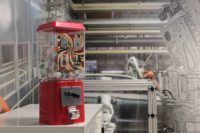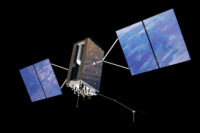Airbus Uses Clean Rooms to Assemble Satellites

In 2020, the Solar Orbiter will be launched from the Cape Canaveral Air Force Station in Florida with an Atlas V rocket. The satellite will travel through space for 3.5 years before reaching its destination point about 42 million kilometers from the Sun. Graphic courtesy European Space Agency

The Clean Cube has an extruded-aluminum frame that is quickly assembled, disassembled and reconfigured. Adjustable exhaust panels enable the end-user to raise or lower the cube’s ISO classification level. Photo courtesy Clean Environments


Sometime in 2020, the Solar Orbiter satellite will begin its several-year journey after being launched from the Cape Canaveral Air Force Station in Florida with an Atlas V rocket. The satellite will travel through space for 3.5 years before reaching its destination point about 42 million kilometers from the Sun—the furthest any spacecraft has ever traveled.
Once there, the satellite will continually orbit the giant star. Ten on-board measuring instruments will gather data about the Sun’s heliosphere, polar regions and the side not visible from the Earth, as well as provide images at an extraordinary resolution (with each pixel representing 70 kilometers of the Sun’s surface). Engineers at the European Space Agency (which is funding the mission) hope to use this data to determine the cause of solar wind, which is the continuous streaming of particles from the Sun.
Airbus Defense and Space built the satellite over several years in an ISO 8 clean room at its spacecraft assembly hall in Stevenage, UK. The satellite’s structural and thermal model was assembled first and then shipped to the IABG aerospace test facility near Munich, Germany. There, sensors were temporarily mounted to the model to measure the impact of noise and vibrations on the spacecraft during launch.
A couple years ago, the satellite’s engineering test bench (which simulates the entire mission) underwent electrical and functional testing at Stevenage. Engineers verified that the spacecraft’s end-to-end electrical properties worked as expected.
Late last year, Airbus needed to assemble, integrate and test the satellite’s most sensitive instruments in an ISO 146441 5 clean room. Airbus asked Clean Environments (CE) if it could provide such a clean room and install it in the Stevenage ISO 8 clean room without any work disruption.
CE said yes and, in only eight weeks, customized its portable class 5 Clean Cube for the application. One of the cube’s main benefits is its ultralow outgassing that decreases magnetic contamination and disperses electrostatic fields.
“We have instruments that are highly sensitive to contamination, which could affect their capabilities and performance in space,” explains Lester Waugh, engineering manager at Airbus. “The Clean Cube was selected [because] it provides high levels of cleanliness, and its flexible design allows it to be [relocated] for future programs, as required.”
The cube has an extruded-aluminum frame that is quickly assembled,
disassembled and reconfigured. Frame-wall infill material varies and is carefully selected by CE engineers to best suit the application.
The cube’s structural T-grid ceiling allows lighting units and a fan filter to be easily moved and repositioned.
Adjustable exhaust panels enable the end-user to raise or lower the cube’s ISO classification level.
At Stevenage, CE’s team quickly positioned the pre-built frame and then added the ceiling grid and wall panels. Flow and particulate monitoring of the cube began shortly thereafter. Within 10 days, Airbus performed outgas, electrostatic and electromagnetic testing of the cube, and determined that it surpassed all ISO 146441 class 5 requirements.
CE was founded in 1997 and initially specialized in temporary clean spaces. The company has since developed several rapid-assembly, HEPA-filtered products for creating portable and permanent clean rooms.
For more information on class 5 clean rooms, call 44-1565-722609 or visit https://cleanenvironments.co.uk.
Looking for a reprint of this article?
From high-res PDFs to custom plaques, order your copy today!








